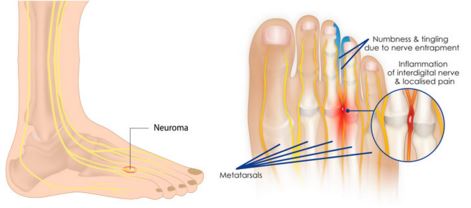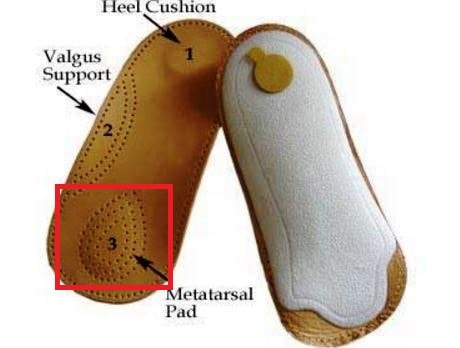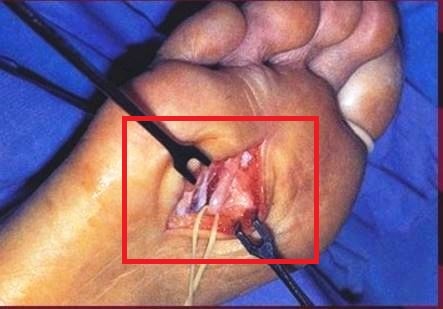Metatarsalgia
What is Metatarsalgia?
The ball of the foot (metatarsal) gets affected due to overuse during running or jumping and causes inflammation and pain, medically this condition is termed as metatarsalgia. It can also occur due to ill fitted wearing of shoe.
The metatarsals are present bind the toes. The biggest metatarsal bone is present behind the first toe. This is not a gender biased symptoms, it can occur in both male and female, but incidence rate is more in case of middle aged over-weight female. This is not a serious health conditions, some restricted life style can help to recover the condition.
Any physical over activity which increases the stress at the head of the metatarsal bone causes Metatarsalgia. This is happened, during the over strain. The head of one metatarsal bone is adjoin with next head of the metatatarsal bone and the tiny nerves present between the metatarsal bones are become pressed and get swollen and pain is develop. The condition become worsen if more strain is put on the affected foot or prolonged standing posture which causes increased collision between the two head of the metatarsal bone and more compression is occur in the nerve and pain and swelling is increased.

Image 1: Overview of Metatarsalgia
Other than these, some diseases also associated with metatarsalgia, which include diabetes, arthritis, bunion, edema and in sustained metatarsalgia may lead to Morton’s neuroma, in which fibrous tissue development occur in between nerve tissues.
Symptoms

Image 2: Symptoms, causes and treatment of Metatarsalgia
- Sharp, acute pain
- Shooting aches mainly in the affected toes
- Burning like sensation
- Specifically, pain is generated at the back portion of the toes
- Pain the affected and restricted in the foot, mainly surrounded part of the toes.
- Pain is become worse during the walking on the hard surface
- Pain become lessened by taking a rest
- Bare feet increase the pain intensity
- Prickling feeling in the toes
Generally gradual development of the pain occurs in metatarsalgia, but sudden acute onset is also very common.
Treatment
RICE
Most commonly applied home based treatment for metatarsalgia is RICE:
- R for rest, avoidance of vigorous exercise and strain generation on the feet and giving some rest on toe bones can provide a reduction of pain and inflammation.
- I for ice, application of ice reduce the burning sensation associated with metatarsalgia.
- C for compression, which can provide by applying elastic or any flexible bandage which can decrease the inflammation
- E for elevation, by providing the support of pillow, elevation of toes more than the heart level also helps to reduce the swelling.
Medications
Medications for management of the acute or chronic pain, the following medications are used:
- Taking of Non-steroidal Anti-Inflammatory drugs, including paracetamol, ibuprofen can help to reduce the inflammation and associated pain.
- In severe pain and inflammation, doctors can prescribe injections of steroidal drugs for reduction of increased pain and inflammation, but this should not be used for prolonged periods, as steroidal drugs are having side effects in case of prolonged use.
Shoes
Some restricted posture including prolong standing or avoidance of ill-fitted shoes including avoidance of high heel shoes can help with the reduction of the pain and inflammation. Application of shock-absorbing insoles inside the shoes improves the comfort and reduces the strain during running or any other physical activities.

Surgery
If the above mentioned therapies do not provide relief, then surgical intervention is the only option. By surgical intervention, overlapping of the toes can be rectified, also reshaped the affected toes and tapped nerve become released which decrease the swelling of a nerve and ultimately reduce the pain.

Exercises
Stretching of the Achilles tendon and ankle exercise also helps with pain and inflammation associated with metatarsalgia. For stretching of the Achilles tendon following steps are important:
Up and down of the ankle joint
To conduct this exercise sit comfortably on a chair and feet should not touch the floor. Now stretched ankle joint downwards, as much as possible, hold for a few seconds. Then stretched upward direction and hold the position for a few seconds. This exercise continues for 10- 15 times and then relaxes.
Rotations
At the beginning of the exercise sit comfortably on the floor and stretched the leg in forward direction and then move the ankle joint clockwise for 10 times and again continue to anti-clockwise for 10 times. Then relax.
Walking on toes
At the start of the exercise stand straight and then slowly stand on the toes and take a round of the room and repeat this for 5 times and then relax.
Recovery Time
Applying after the RICE, usual recovery period is 48 hours.
References
- http://www.nhs.uk/Conditions/metatarsalgia/Pages/Treatment.aspx
- http://www.webmd.com/a-to-z-guides/metatarsalgia?page=2
- http://www.mayoclinic.org/diseases-conditions/metatarsalgia/basics/symptoms/con-20022369
- http://www.livestrong.com/article/366409-foot-exercises-for-metatarsal-pain/
- http://www.medicalnewstoday.com/articles/190431.php
